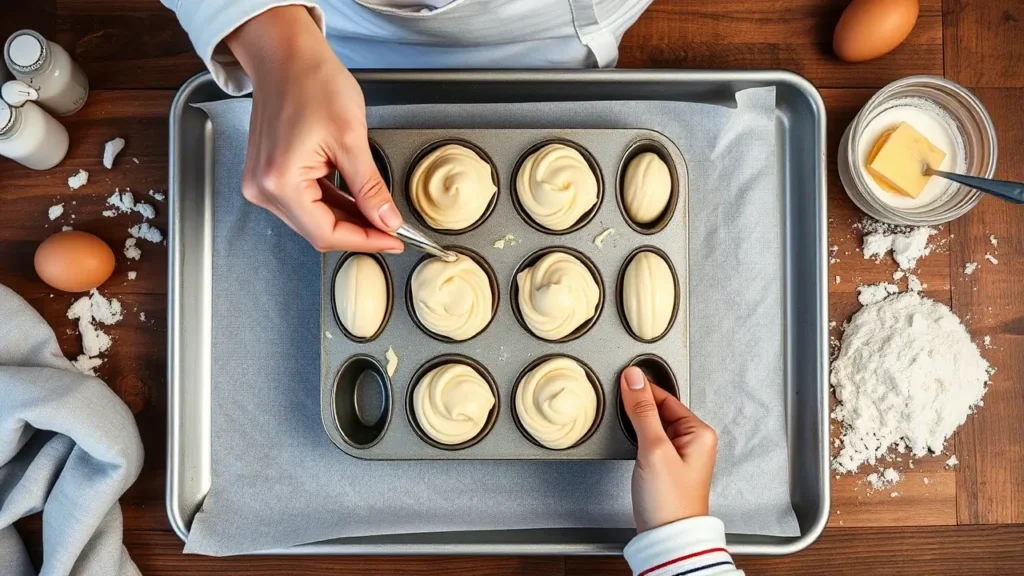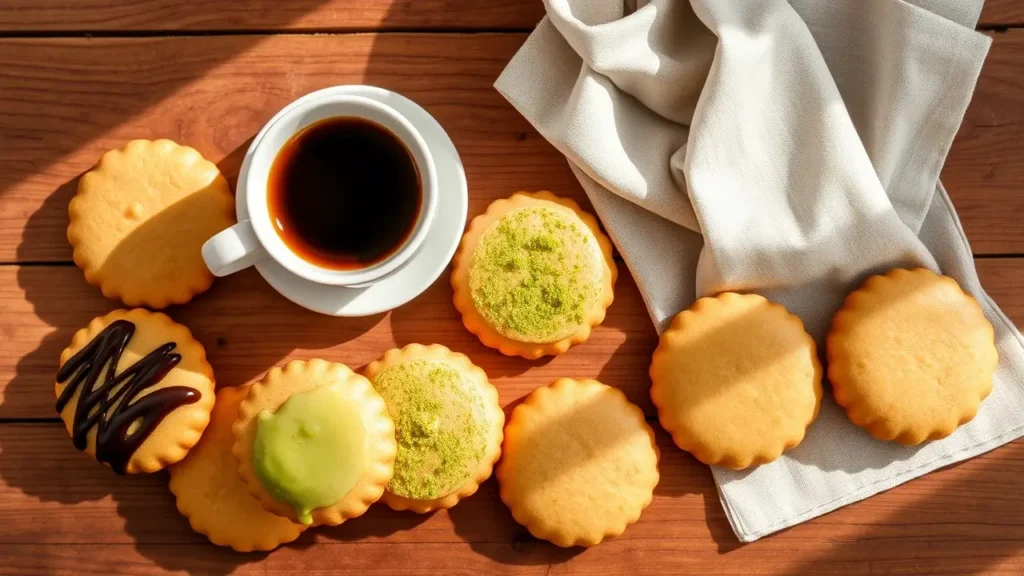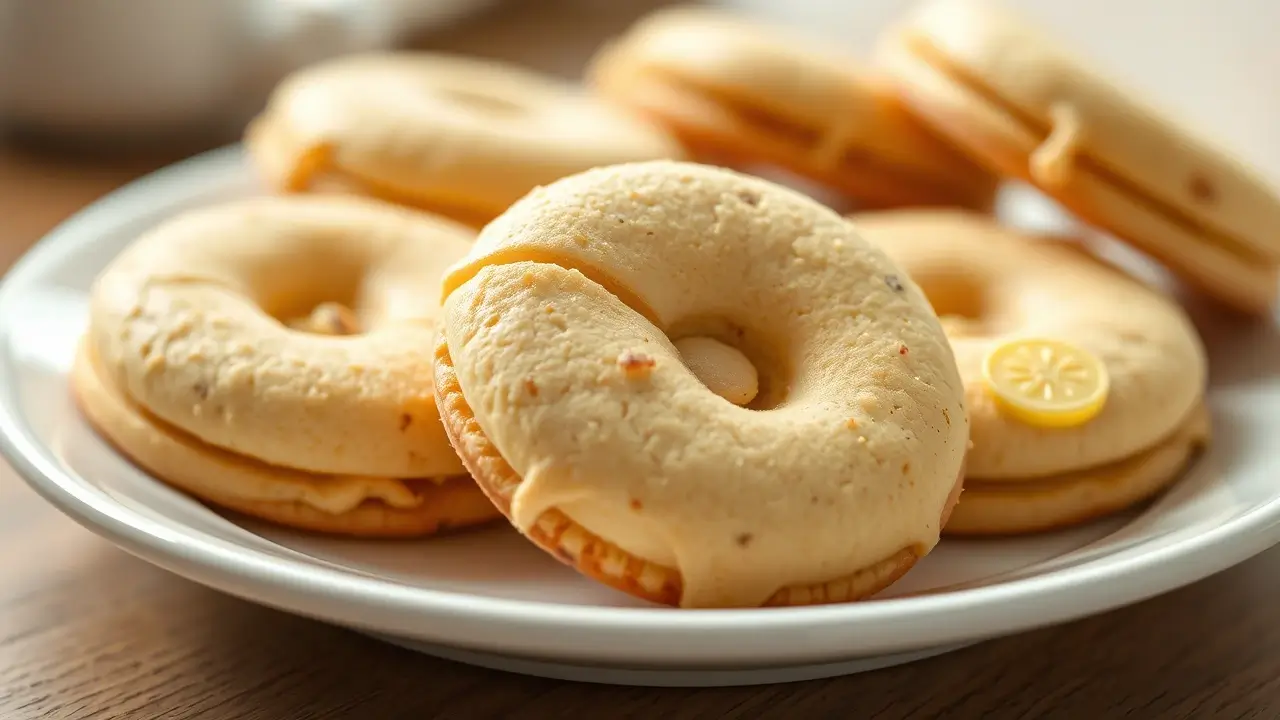There’s something magical about a well-made madeline cookies recipe using cream. Golden, light, and slightly crisp on the edges, yet melt-in-your-mouth soft inside, these delicate, shell-shaped treats have been a French favorite for centuries. Today, we’re giving them a rich and luxurious twist by incorporating cream into the batter.
In this article, we’ll explore everything you need to know about making the perfect batch of madeline cookies using cream. From selecting the right type of cream and mastering the baking process to experimenting with flavor variations and storing them properly, we’ve got you covered!
So, whether you’re a seasoned baker or a beginner looking for an easy yet impressive treat, follow along as we break down each step in detail. Let’s get started!
What Are Madeline Cookies?
A madeline cookies recipe using cream brings a delightful twist to these small, shell-shaped sponge cakes from France. Traditionally made with butter, sugar, eggs, and flour, Madeleines are known for their delicate crumb, golden hue, and slightly crisp edges. By adding cream to the batter, we make these classic French treats even richer and softer, while keeping their signature airy texture.
Why Use Cream in the Recipe?
If you’ve ever been disappointed by a dry Madeleine, adding cream to the batter is the solution! Madeline cookies recipe using cream ensures the cookies are:
- Silkier texture that melts in your mouth.
- Richer flavor, making them more decadent than traditional Madeleines.
- Better moisture retention, keeping them soft longer.
Choosing the right cream – like heavy cream for richness or whole milk cream for a lighter touch – will elevate your madeline cookies recipe using cream to perfection!
The Origin and Popularity of Madeleines
Madeleines have been a French favorite for centuries, with origins tracing back to Commercy in the 18th century. The madeline cookies recipe using cream has evolved, but their popularity remains unchanged, from royal courts to modern-day tea parties.
Essential Ingredients for the Perfect Madeline Cookies:
For a successful madeline cookies recipe using cream, it’s crucial to select the best ingredients and carefully balance wet and dry components to get that classic light texture.
Choosing the Right Type of Cream
Not all creams work equally well in your madeline cookies recipe using cream. The type of cream you choose affects the final texture and richness. Here’s what to consider:
- Heavy Cream (Whipping Cream) – This cream gives the madeline cookies recipe using cream its richest, most luxurious texture.
- Whole Milk Cream – A lighter option for fluffier, less dense cookies.
- Half-and-Half or Light Cream – While acceptable, these options are less rich.
For best results in your madeline cookies recipe using cream, opt for heavy cream for a tender, moist crumb.
Key Ingredients Breakdown
In addition to cream, several key ingredients ensure your madeline cookies recipe using cream turns out perfectly:
- Flour – Use all-purpose flour for the best texture. Be sure to sift it to remove lumps.
- Eggs – They naturally help the cookies rise, creating their signature lightness.
- Butter – Butter adds richness and enhances the golden color of your cookies.
- Sugar – Granulated sugar provides sweetness and a delicate crispness on the edges.
- Baking Powder – This ingredient helps the cookies rise, ensuring they’re fluffy rather than dense.
- Vanilla Extract – Vanilla deepens the flavor, giving the cookies a subtle aromatic profile.
- Lemon Zest (Optional) – Adds a light citrusy note that complements the richness of the cream.
Flavor Enhancers and Additions
While the classic madeline cookies recipe using cream is delicious on its own, you can try these variations to personalize your treats:
- Chocolate – Add 2 tablespoons of cocoa powder to the dry ingredients for a chocolatey twist.
- Nuts – Fold in ¼ cup of chopped almonds or hazelnuts for added texture.
- Spices – A touch of cinnamon or nutmeg creates a warm, spiced version perfect for fall.
Step-by-Step Madeline Cookies Recipe Using Cream:

A baker pipes creamy madeleine batter into a metal mold for perfect results.
Now that we have the perfect ingredients, let’s walk through the baking process step by step. Follow these instructions carefully, and you’ll have golden, fluffy Madeleines every time.
Preparing the Batter
- Whisk the Eggs and Sugar – In a mixing bowl, beat 2 large eggs and ½ cup sugar until the mixture becomes pale and slightly foamy. This aeration helps create a light, fluffy texture.
- Incorporate the Cream – Slowly add ½ cup heavy cream, whisking continuously until fully blended.
- Sift the Dry Ingredients – In a separate bowl, mix 1 cup all-purpose flour, 1 teaspoon baking powder, and a pinch of salt. Sifting prevents clumps and ensures even mixing.
- Fold in Dry Ingredients – Gently fold the dry ingredients into the wet mixture. Be careful not to overmix, as it can make the cookies dense.
- Add Melted Butter and Vanilla – Stir in ⅓ cup melted unsalted butter and 1 teaspoon vanilla extract for a rich flavor.
Chilling the Batter for the Signature Hump
One of the secrets to a perfect Madeline cookies recipe using cream is the chilling step. Refrigerating the batter before baking helps develop the signature hump that defines a true Madeleine.
- Cover the batter and chill for at least 30 minutes (or up to 2 hours).
- The contrast between cold batter and a hot oven creates the ideal puffiness.
Skipping this step may result in flat Madeleines, so do not rush.
Baking to Perfection
- Preheat the Oven – Set it to 375°F (190°C) and grease a Madeleine mold with butter.
- Fill the Molds – Spoon about ¾ full into each mold to leave space for rising.
- Bake for 10–12 Minutes – Until the edges turn golden brown, and the center springs back when touched.
- Cool Before Serving – Let the cookies rest in the pan for a few minutes before transferring them to a wire rack.
How to Achieve the Light, Airy Texture
To make sure your Madeline cookies recipe using cream turns out perfectly every time:
- Whip the eggs and sugar well – This creates a light, airy structure.
- Do not overmix the batter – Overworking the flour can make the cookies tough.
- Use room temperature ingredients – Helps with even blending.
- Avoid opening the oven door – Sudden temperature changes can cause sinking.
Common Mistakes When Making Madeline Cookies and How to Avoid Them:
Even with a well-tested Madeline cookies recipe using cream, certain mistakes can lead to disappointing results. Understanding these common errors and how to fix them will help ensure light, fluffy, and perfectly textured Madeleines every time.
Overmixing the Batter
One of the biggest mistakes is overmixing the batter. When you stir the ingredients too much, you develop excess gluten, which can make the cookies dense and tough instead of light and airy.
Solution: Gently fold the dry ingredients into the wet mixture just until combined. It’s okay if the batter has some lumps; they will smooth out during baking.
Skipping the Chilling Step
Many bakers rush the process and bake the Madeleines immediately after mixing. However, chilling the batter is essential for achieving the signature hump and proper texture.
Solution: Refrigerate the batter for at least 30 minutes before baking. The cold batter will react with the heat, helping the cookies puff up properly.
Filling the Molds Incorrectly
If you overfill or underfill the molds, the cookies may not rise properly, or they could spread too much.
Solution: Fill each cavity about three-quarters full to allow enough room for the cookies to expand while baking.
Using the Wrong Oven Temperature
A common problem is baking at the wrong temperature. If the oven is too hot, the edges will burn while the centers remain undercooked. If it’s too low, the cookies won’t rise properly.
Solution: Always preheat your oven to 375°F (190°C) and use an oven thermometer if necessary to ensure accurate heat levels.
Not Greasing the Madeleine Mold Properly
Even nonstick molds can cause Madeleines to stick if they aren’t greased well.
Solution: Brush the molds lightly with melted butter and dust them with flour to ensure easy release.
By avoiding these common mistakes, you’ll consistently bake perfectly golden Madeleines with a soft, pillowy texture.
How to Store and Serve Madeline Cookies for Maximum Freshness:
Once you have successfully baked your Madeline cookies recipe using cream, proper storage and serving methods will ensure they stay fresh, moist, and delicious for as long as possible.
Best Ways to Store Madeleines
Since Madeleines are best when fresh, storing them properly is crucial.
- At Room Temperature: Place the cookies in an airtight container and store them at room temperature for up to 3 days.
- In the Refrigerator: If you want to keep them longer, refrigerate them in a sealed container for up to a week.
- In the Freezer: Freeze the cookies in a single layer on a baking sheet, then transfer them to a freezer-safe bag. They will last for up to 2 months.
Tip: To bring back their fresh-baked texture, warm the cookies in a 300°F (150°C) oven for a few minutes before serving.
How to Keep Madeleines Moist
Madeleines can dry out quickly if not stored correctly. Here’s how to keep them moist:
- Use an airtight container to prevent air exposure.
- Add a small piece of bread in the container to retain moisture.
- Avoid stacking them while warm, as steam can make them soggy.
Serving Suggestions
Madeline cookies are versatile and pair well with a variety of drinks and toppings. Here are some creative serving ideas:
- With Tea or Coffee: The slightly crisp edges and soft center make Madeleines perfect for dunking.
- Dust with Powdered Sugar: A light dusting enhances the sweetness and adds an elegant touch.
- Drizzle with Chocolate: Melted dark or white chocolate makes for a decadent topping.
- Serve with Fresh Fruit: A side of berries or citrus slices complements their delicate flavor.
For an extra indulgence, you can also serve them with a scoop of vanilla ice cream or a dollop of whipped cream.
For more delicious baking recipes, check out our Chocolate Chunk Cookie Recipe.
Madeleine Cookie Variations and Flavor Twists:

A variety of madeleine cookies, including chocolate, lemon, and matcha flavors.
While the Madeline cookies recipe using cream is already a classic delight, adding new flavors can make them even more exciting. Whether you prefer chocolate, citrus, or nutty flavors, there’s a variation for everyone.
Chocolate-Dipped Madeleines
For chocolate lovers, dipping Madeleines in melted chocolate is an easy way to enhance their richness.
How to Make Chocolate-Dipped Madeleines:
- Melt ½ cup of chocolate chips (dark, milk, or white) with 1 teaspoon of butter.
- Dip half of each cooled Madeleine into the melted chocolate.
- Place on parchment paper and allow the chocolate to set before serving.
For extra texture, sprinkle chopped nuts or coconut flakes on the chocolate before it hardens.
Lemon or Orange Zest Madeleines
Citrus zest adds a refreshing brightness to the cookies without overpowering their delicate flavor.
How to Add a Citrus Twist:
- Mix 1 tablespoon of finely grated lemon or orange zest into the batter.
- Replace vanilla extract with ½ teaspoon of lemon or orange extract for a stronger flavor.
- Dust the finished Madeleines with powdered sugar and a little zest for an extra touch.
Almond or Pistachio Madeleines
Adding nuts can enhance both the flavor and texture of your cookies.
Steps for a Nutty Variation:
- Replace ¼ cup of flour with finely ground almonds or pistachios.
- Toast the nuts before grinding to bring out their natural oils and flavor.
- Garnish with sliced almonds or crushed pistachios for a decorative touch.
These variations make it easy to customize your Madeline cookies recipe using cream to suit any occasion or personal taste.
Frequently Asked Questions About Madeleines:
Madeleines may seem simple, but many bakers have questions about how to get them just right. Here are answers to some of the most common questions.
How Do You Keep Madeleines Moist?
To keep Madeleines soft and moist, store them in an airtight container at room temperature. Adding a small piece of bread or a sugar cube inside the container can help retain moisture.
What Makes Madeleines So Good?
Madeleines have a unique texture that’s a cross between a cake and a cookie. Their slightly crisp edges and soft, buttery center make them incredibly satisfying, especially when paired with coffee or tea.
What’s a Substitute for Madeleine Molds?
If you don’t have a Madeleine pan, you can use a mini muffin tin as a substitute. While the shape won’t be the same, the texture and taste will remain delicious.
What’s the Difference Between a Cake and a Madeleine?
Though similar to sponge cake, Madeleines have a distinct, shell-like shape and a firmer texture due to the unique baking method. Unlike a traditional cake, they are lighter, smaller, and best enjoyed fresh.
Traditional vs. Modern Madeleine Recipes:
Classic French Madeleine Recipe
The traditional French madeleine follows a simple yet time-honored process. It typically includes flour, eggs, sugar, butter, and a hint of vanilla or lemon zest. The key to achieving its signature hump is allowing the batter to rest before baking at a high temperature. While the traditional recipe doesn’t use cream, it remains a staple in French bakeries and homes.
Modern Adaptations – Using Cream for a Richer Texture
In contrast, modern variations, such as the madeline cookies recipe using cream, elevate the classic by adding heavy cream. The cream enhances the texture, making the cookies softer and more indulgent. Additionally, contemporary versions explore diverse flavors, from chocolate-infused batter to matcha and almond flour alternatives.
Best Tools and Ingredients for Perfect Madeleines:
Essential Bakeware for Perfect Results
To achieve the best results, investing in the right bakeware is crucial. A well-greased, non-stick madeleine pan is necessary for the cookies’ signature shell shape. Silicone molds are available, but traditional metal pans yield a better rise and crispier edges.
Choosing High-Quality Ingredients
For the best madeleine cookies recipe using cream, always opt for high-quality ingredients. Use fresh eggs, full-fat heavy cream, pure vanilla extract, and European-style butter for a richer flavor. Additionally, sifting the flour ensures a light and airy texture, preventing dense or dry cookies.
To conclude, madeleine cookies made with cream offer a rich, moist texture that sets them apart from traditional versions. The heavy cream enhances the batter’s softness while locking in moisture, ensuring they stay fresh for longer. Whether you enjoy them with coffee, tea, or dipped in chocolate, these delicate French treats are a delightful addition to any occasion.
For a detailed step-by-step guide and additional flavor variations, check out this madeleine recipe with cream.


1 thought on “Madeline Cookies Recipe Using Cream -Is This the Best Version?”
Comments are closed.